Rolling Bearing Performance Degradation Assessment with Adaptive Sensitive Feature Selection and Multi-Strategy Optimized SVDD
Abstract
1. Introduction
2. Determination of the Adaptive Sensitive Feature Set
2.1. Feature Extraction
2.2. Feature Evaluation with Multiple Criteria
- (1)
- Monotonicity: The degradation of rolling bearings’ performance is an irreversible process, so the features should be able to monotonically characterize the process of rolling bearings from operation to failure. Because the time vector is strictly monotonic, the correlation coefficient between the feature vector and the time vector is used to measure the monotonicity of the feature [19]. In practice, rolling bearings often show a nonlinear degradation trend. The Spearman’s rank correlation coefficient is widely applicable and is more sensitive to nonlinear correlation [1], so this study calculated the Spearman’s rank correlation coefficient as the monotonicity index of the feature. The monotonicity score’s equation is shown in Equation (1) [3] as:
- (2)
- Robustness: During the use of rolling bearings, the signal acquisition process is inevitably disturbed by the environment, changes in the working condition, and noise. The robustness index is used to measure the tolerance of the features to random noise and abnormal values [19]. Equation (2) is used for calculating the robustness score of features, which is a widely used and interpretable equation for calculating the robustness index of features [1], as follows:
- (3)
- Correlation: The correlation index is used to measure whether the feature can capture the trend of the degradation in performance across the life cycle of rolling bearings [20]. The equation for calculating the correlation score is shown in Equation (3), which can measure the change trend of the features across the whole life cycle [3], as:
2.3. Adaptive Sensitive Feature Selection
3. Multi-Strategy Optimized Support Vector Data Description
3.1. Support Vector Data Description
3.2. Construction of the Multi-Kernel Function
3.3. Auto-Associative Kernel Regression
3.4. Parameters of SVDD and Indicators of Degradation
4. Steps of the Algorithm for Assessing Degradation
5. Experimental Verification
5.1. Case 1: XJTU-SY Bearing Datasets
5.1.1. Experimental Description of Case 1
5.1.2. Experimental Result of Case 1
5.2. Case 2: IEEE PHM2012 Data Challenge Dataset
5.2.1. Experimental Description of Case 2
5.2.2. Experimental Result of Case 2
5.3. Case 3: Bearing Data from a Home-Made Test Bench
5.3.1. Experimental Description of Case 3
5.3.2. Experimental Result of Case 3
6. Conclusions
- (1)
- The TOPSIS–K-medoids method was proposed for adaptive determination of the sensitive feature set. This method determines the adaptive sensitive feature set by using the monotonicity, correlation, and robustness indexes for evaluation, and the process does not need to rely on a priori knowledge to subjectively determine parameters such as the weights and thresholds, which improves the quality of the input data used for the PDA model.
- (2)
- The multi-strategy optimized SVDD strategy trained the model using only the early samples of the healthy phase, adaptively determined the FPT, overcame the interference of outliers and false fluctuations, and better characterized the bearings’ degree of failure. The HI showed better consistency with the development trend of faults.
- (3)
- After verification with the XJTU-SY bearing data, the IEEE PHM2012 Data Challenge dataset for bearings, and data obtained with a self-made test bench of accelerated fatigue in rolling bearings, the multi-strategy optimized SVDD model proposed in this paper demonstrated better performance compared to multiple mainstream methods according to a comparison of multiple evaluation indexes, such as monotonicity, correlation, robustness, and separability.
Author Contributions
Funding
Institutional Review Board Statement
Informed Consent Statement
Data Availability Statement
Conflicts of Interest
References
- Lei, Y.; Li, N.; Guo, L.; Li, N.; Yan, T.; Lin, J. Machinery health prognostics: A systematic review from data acquisition to RUL prediction. Mech. Syst. Signal Process. 2018, 104, 799–834. [Google Scholar] [CrossRef]
- Schmidt, S.; Heyns, P.S.; Gryllias, K.C. An informative frequency band identification framework for gearbox fault diagnosis under time-varying operating conditions. Mech. Syst. Signal Process. 2021, 158, 107771. [Google Scholar] [CrossRef]
- Yu, H.; Li, H. Pump remaining useful life prediction based on multi-source fusion and monotonicity-constrained particle filtering. Mech. Syst. Signal Process. 2022, 170, 108851. [Google Scholar] [CrossRef]
- Li, Y.; Liang, X.; Lin, J.; Chen, Y.; Liu, J. Train axle bearing fault detection using a feature selection scheme based multi-scale morphological filter. Mech. Syst. Signal Process. 2018, 101, 435–448. [Google Scholar] [CrossRef]
- Wang, Z.; Huang, H.; Wang, Y. Fault diagnosis of planetary gearbox using multi-criteria feature selection and heterogeneous ensemble learning classification. Measurement 2021, 173, 108654. [Google Scholar] [CrossRef]
- Yi, J.; Fang, Z.; Yang, G.; He, S.; Gao, S. New feature analysis-based elastic net algorithm with clustering objective function. Knowl. -Based Syst. 2022, 258, 110004. [Google Scholar] [CrossRef]
- Long, J.; Chen, Y.; Yang, Z.; Huang, Y.; Li, C. A novel self-training semi-supervised deep learning approach for machinery fault diagnosis. Int. J. Prod. Res. 2022, 1–14. [Google Scholar] [CrossRef]
- Shao, H.; Xia, M.; Han, G.; Zhang, Y.; Wan, J. Intelligent Fault Diagnosis of Rotor-Bearing System Under Varying Working Conditions with Modified Transfer Convolutional Neural Network and Thermal Images. IEEE Trans. Ind. Inform. 2021, 17, 3488–3496. [Google Scholar] [CrossRef]
- Zhang, Y.; Li, X.; Gao, L.; Chen, W.; Li, P. Ensemble deep contractive auto-encoders for intelligent fault diagnosis of machines under noisy environment. Knowl. -Based Syst. 2020, 196, 105764. [Google Scholar] [CrossRef]
- Xia, J.; Li, Z.; Gao, X.; Guo, Y.; Zhang, X. Real-Time Sensor Fault Identification and Remediation for Single-Phase Grid-Connected Converters Using Hybrid Observers with Unknown Input Adaptation. IEEE Trans. Ind. Electron. 2023, 70, 2407–2418. [Google Scholar] [CrossRef]
- Rai, A.; Upadhyay, S.H. An integrated approach to bearing prognostics based on EEMD-multi feature extraction, Gaussian mixture models and Jensen-Rényi Divergence. Appl. Soft Comput. 2018, 71, 36–50. [Google Scholar] [CrossRef]
- Pan, Y.; Chen, J.; Li, X. Bearing performance degradation assessment based on lifting wavelet packet decomposition and fuzzy c-means. Mech. Syst. Signal Process. 2010, 24, 559–566. [Google Scholar] [CrossRef]
- Wang, H.; Ni, G.; Chen, J.; Qu, J. Research on rolling bearing state health monitoring and life prediction based on PCA and Internet of things with multi-sensor. Measurement 2020, 157, 107657. [Google Scholar] [CrossRef]
- Liu, C.; Gryllias, K. A semi-supervised Support Vector Data Description-based fault detection method for rolling element bearings based on cyclic spectral analysis. Mech. Syst. Signal Process. 2020, 140, 106682. [Google Scholar] [CrossRef]
- Yang, C.; Ma, J.; Wang, X.; Li, X.; Li, Z.; Luo, T. A novel based-performance degradation indicator RUL prediction model and its application in rolling bearing. ISA Trans. 2022, 121, 349–364. [Google Scholar] [CrossRef]
- Song, H.; Kim, M.; Park, D.; Shin, Y.; Lee, J.G. Learning from Noisy Labels with Deep Neural Networks: A Survey. In IEEE Transactions on Neural Networks and Learning Systems; IEEE: New York, NY, USA, 2022; pp. 1–19. [Google Scholar] [CrossRef]
- Wu, X.; Liu, S.; Bai, Y. The manifold regularized SVDD for noisy label detection. Inf. Sci. 2023, 619, 235–248. [Google Scholar] [CrossRef]
- Wu, J.; Wu, C.; Cao, S.; Or, S.W.; Deng, C.; Shao, X. Degradation Data-Driven Time-To-Failure Prognostics Approach for Rolling Element Bearings in Electrical Machines. IEEE Trans. Ind. Electron. 2019, 66, 529–539. [Google Scholar] [CrossRef]
- Javed, K.; Gouriveau, R.; Zerhouni, N.; Nectoux, P. Enabling Health Monitoring Approach Based on Vibration Data for Accurate Prognostics. IEEE Trans. Ind. Electron. 2015, 62, 647–656. [Google Scholar] [CrossRef]
- Liu, L.; Yu, D. Density Peaks Clustering Algorithm Based on Weighted k-Nearest Neighbors and Geodesic Distance. IEEE Access 2020, 8, 168282–168296. [Google Scholar] [CrossRef]
- Tax, D.M.J.; Duin, R.P.W. Support vector domain description. Pattern Recognit. Lett. 1999, 20, 1191–1199. [Google Scholar] [CrossRef]
- Louhichi, S.; Gzara, M.; Abdallah, H.B. A density based algorithm for discovering clusters with varied density. In Proceedings of the 2014 World Congress on Computer Applications and Information Systems (WCCAIS), Hammamet, Tunisia, 17–19 January 2014; pp. 1–6. [Google Scholar]
- Guo, W.; Wang, Z.; Hong, S.; Li, D.; Yang, H.; Du, W. Multi-kernel Support Vector Data Description with boundary information. Eng. Appl. Artif. Intell. 2021, 102, 104254. [Google Scholar] [CrossRef]
- Xian, H.; Che, J. Unified whale optimization algorithm based multi-kernel SVR ensemble learning for wind speed forecasting. Appl. Soft Comput. 2022, 130, 109690. [Google Scholar] [CrossRef]
- Okhli, K.; Jabbari Nooghabi, M. On the contaminated exponential distribution: A theoretical Bayesian approach for modeling positive-valued insurance claim data with outliers. Appl. Math. Comput. 2021, 392, 125712. [Google Scholar] [CrossRef]
- Baraldi, P.; Di Maio, F.; Turati, P.; Zio, E. Robust signal reconstruction for condition monitoring of industrial components via a modified Auto Associative Kernel Regression method. Mech. Syst. Signal Process. 2015, 60–61, 29–44. [Google Scholar] [CrossRef]
- Brandsæter, A.; Vanem, E.; Glad, I.K. Efficient on-line anomaly detection for ship systems in operation. Expert Syst. Appl. 2019, 121, 418–437. [Google Scholar] [CrossRef]
- Zhang, J.; Zhang, Q.; Qin, X.; Sun, Y. A two-stage fault diagnosis methodology for rotating machinery combining optimized support vector data description and optimized support vector machine. Measurement 2022, 200, 111651. [Google Scholar] [CrossRef]
- Wang, P.; Long, Z.; Wang, G. A hybrid prognostics approach for estimating remaining useful life of wind turbine bearings. Energy Rep. 2020, 6, 173–182. [Google Scholar] [CrossRef]
- Song, Y.; Liu, D.; Hou, Y.; Yu, J.; Peng, Y. Satellite lithium-ion battery remaining useful life estimation with an iterative updated RVM fused with the KF algorithm. Chin. J. Aeronaut. 2017, 31, 31–40. [Google Scholar] [CrossRef]
- Li, N.; Lei, Y.; Lin, J.; Ding, S.X. An Improved Exponential Model for Predicting Remaining Useful Life of Rolling Element Bearings. IEEE Trans. Ind. Electron. 2015, 62, 7762–7773. [Google Scholar] [CrossRef]
- Nectoux, P.; Gouriveau, R.; Medjaher, K.; Ramasso, E.; Chebel-Morello, B.; Zerhouni, N.; Varnier, C. PRONOSTIA: An Experimental Platform for Bearings Accelerated Degradation Tests; IEEE: New York, NY, USA, 2012; pp. 1–8. [Google Scholar]
- Wang, Z.; Wu, X.; Liu, X.; Cao, Y.; Xie, J. Research on feature extraction algorithm of rolling bearing fatigue evolution stage based on acoustic emission. Mech. Syst. Signal Process. 2018, 113, 271–284. [Google Scholar] [CrossRef]



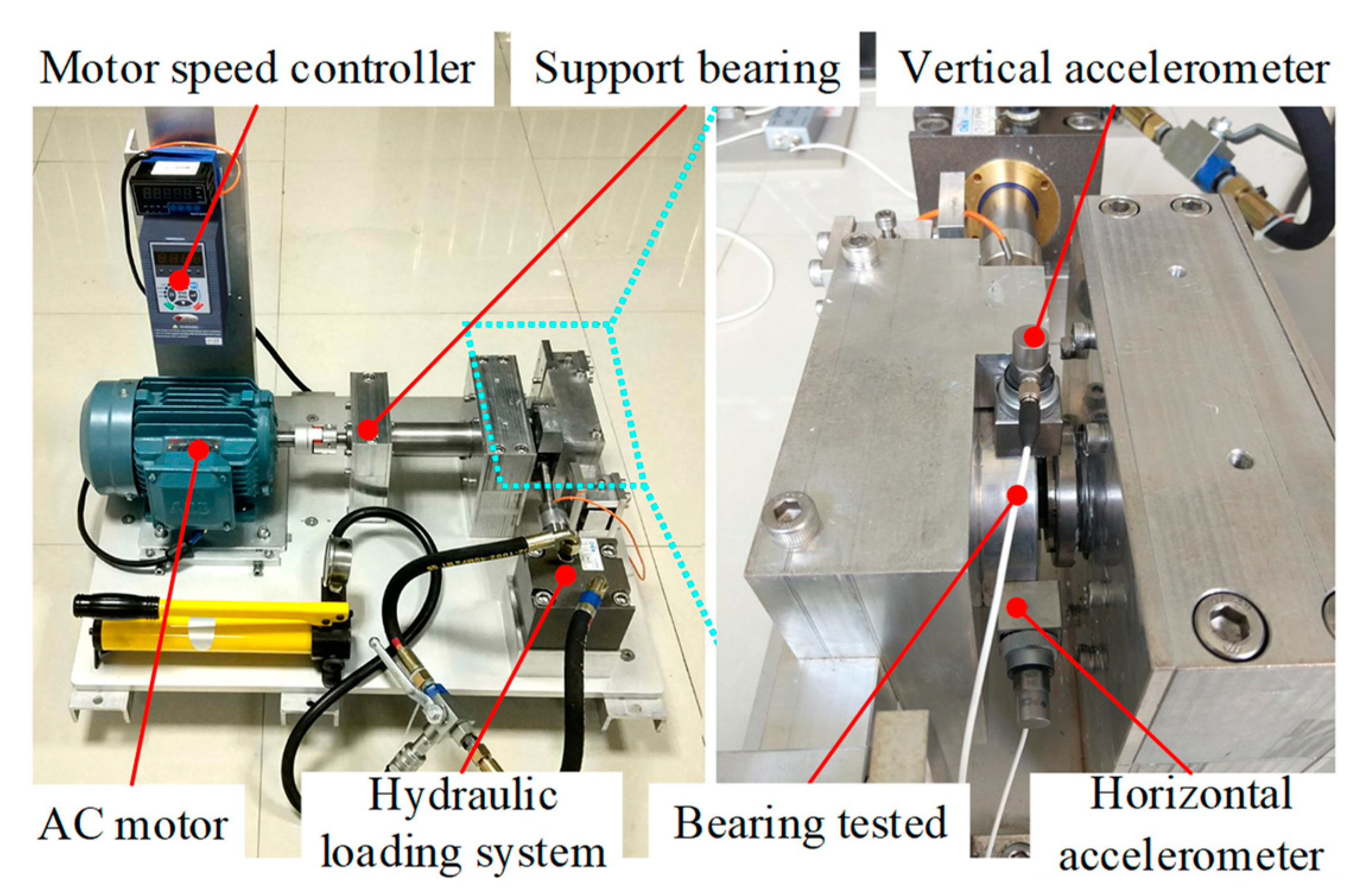

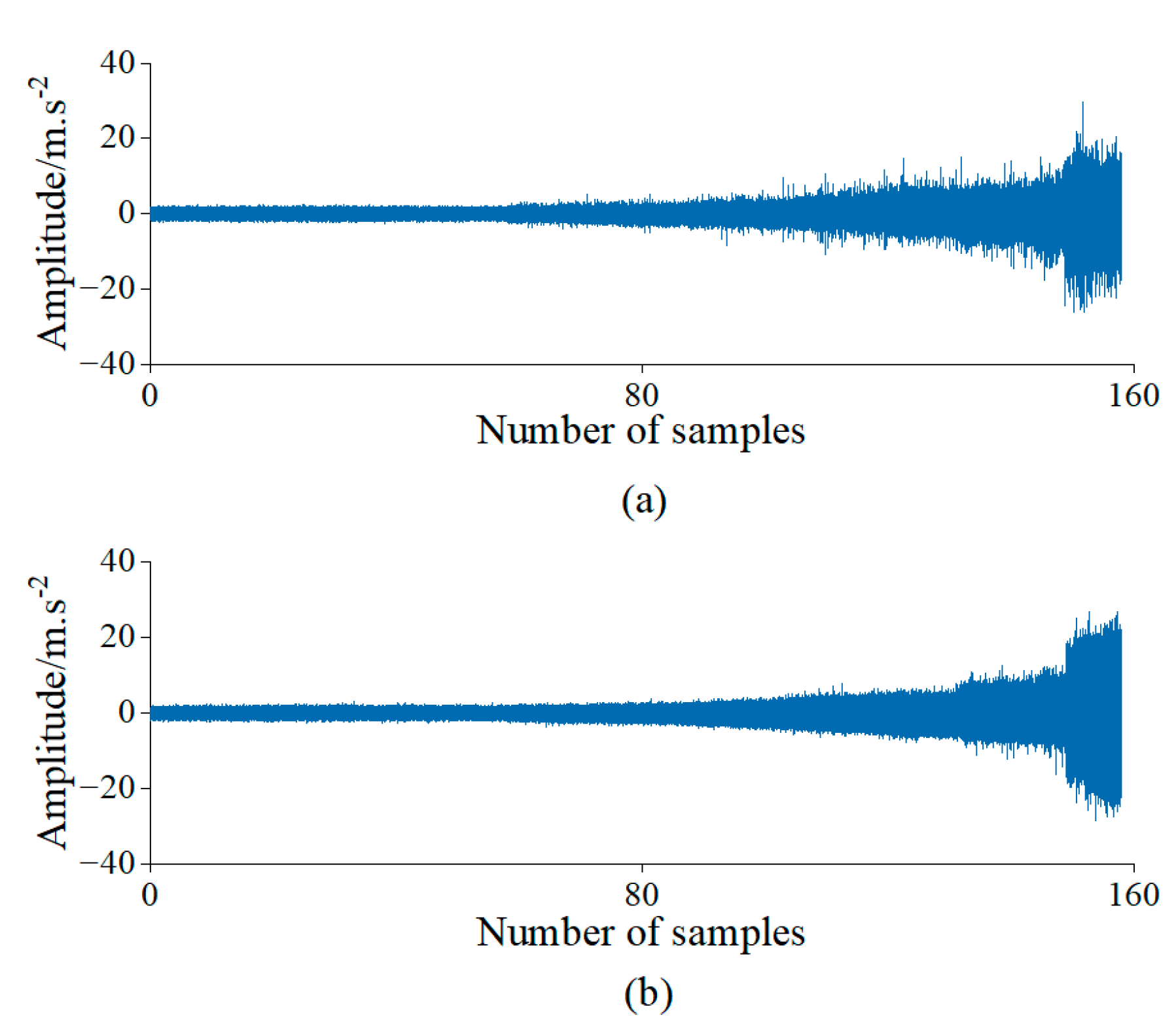
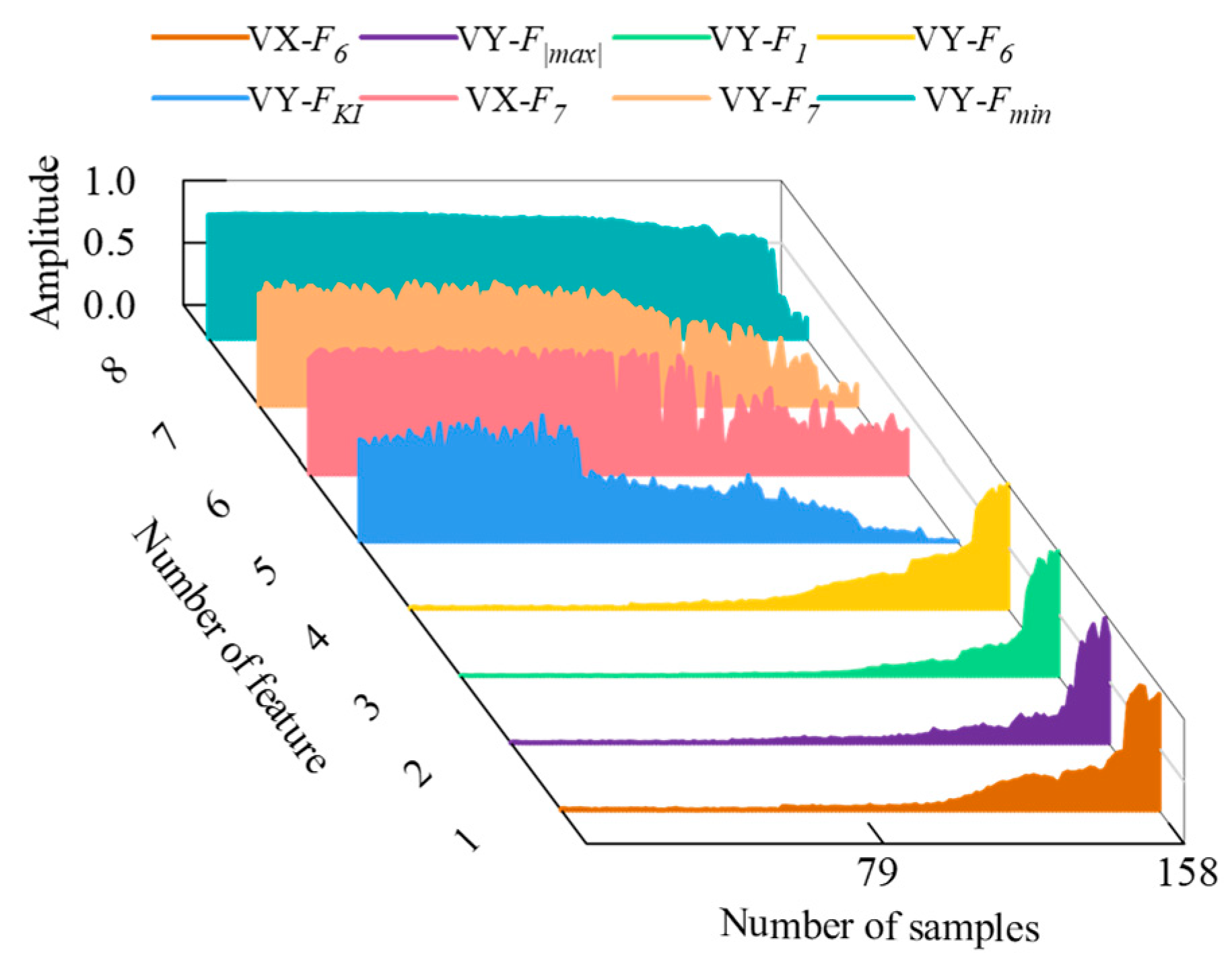
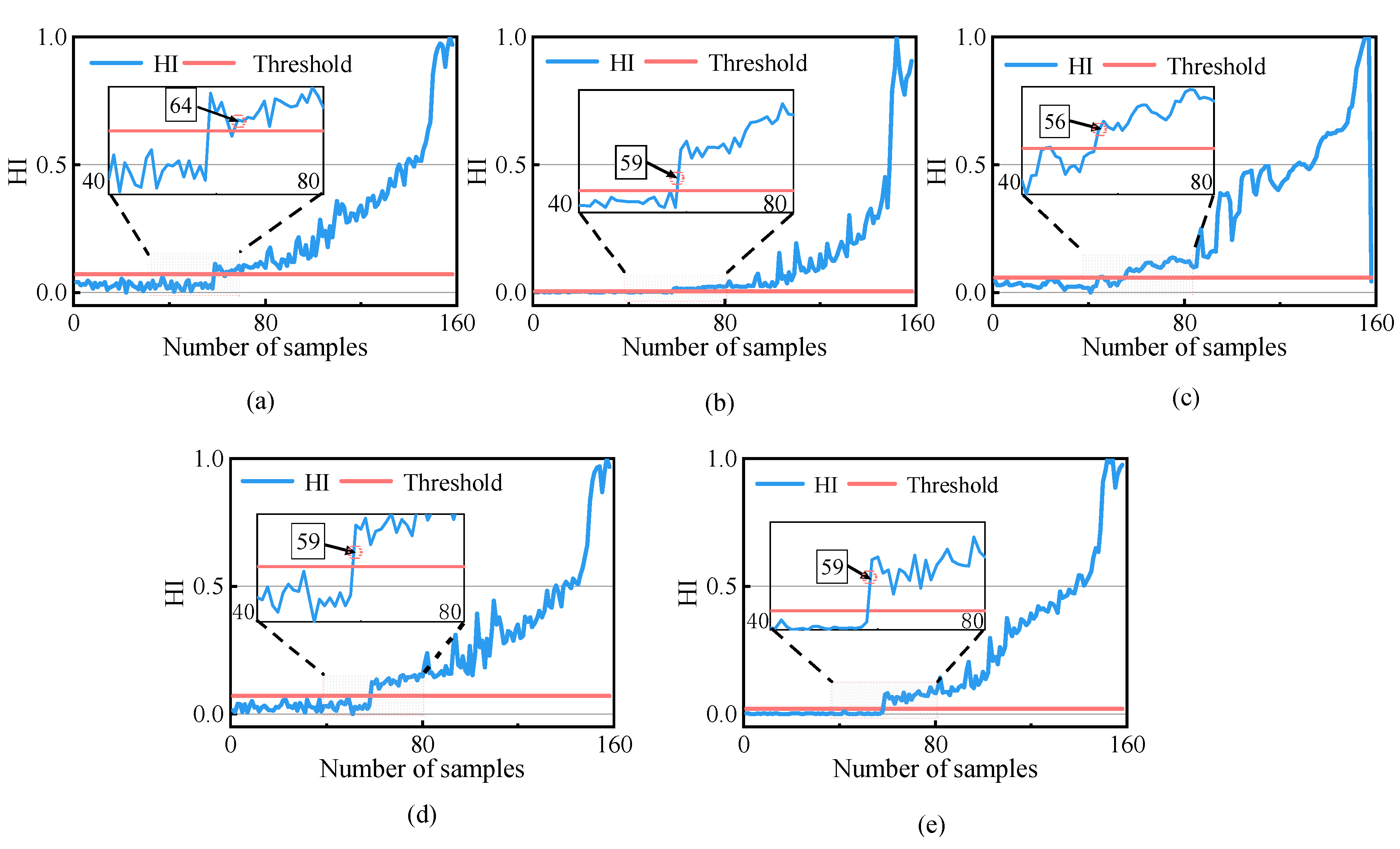



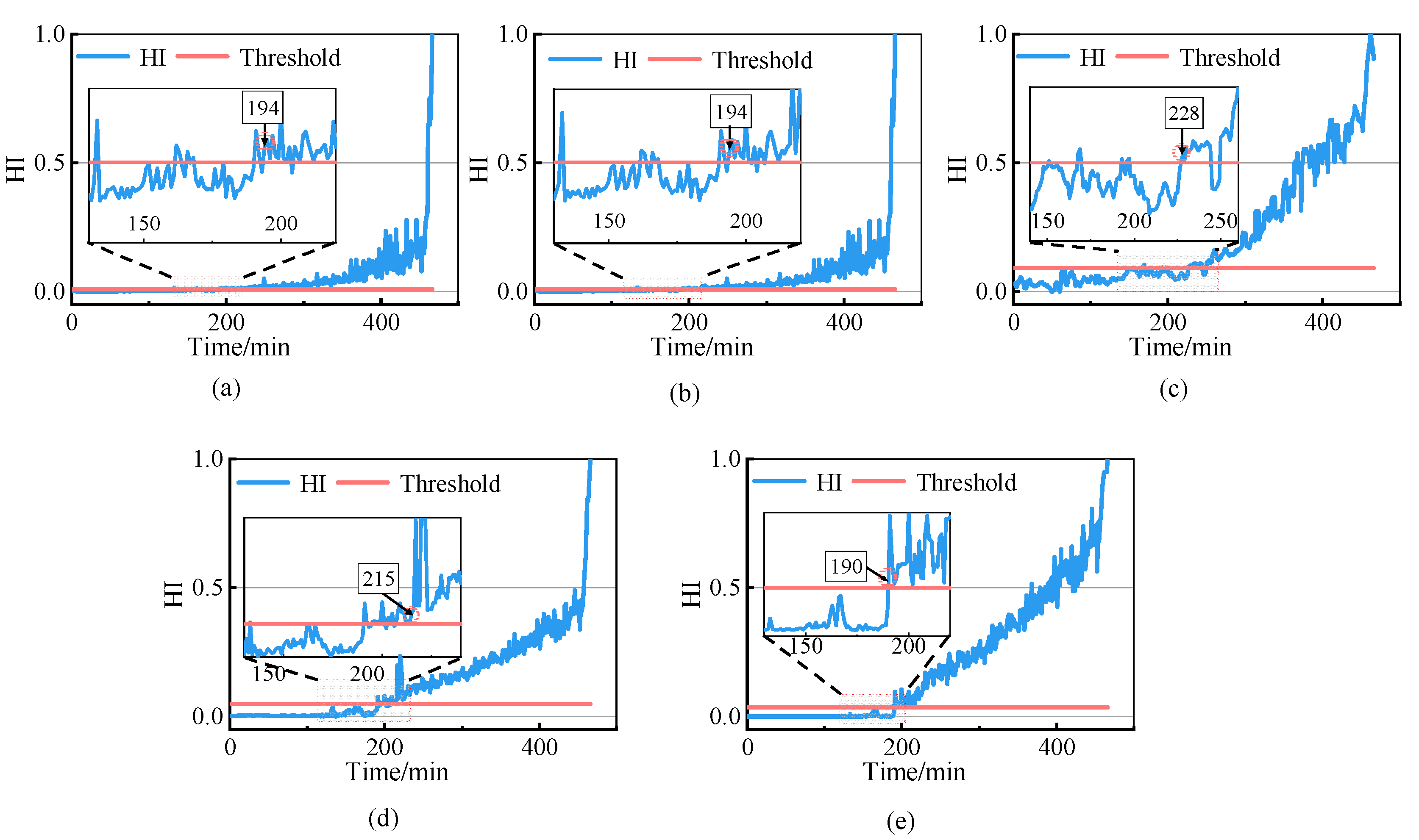



| Name | Equation | Name | Equation |
|---|---|---|---|
| Mean value | Standard deviation | ||
| Average amplitude | Variance | ||
| Maximum value | Kurtosis | ||
| Minimum value | Skewness | ||
| Peak value | Waveform index | ||
| Peak to peak value | Peak index | ||
| Root mean square | Impulse index | ||
| Root amplitude | Tolerance index | ||
| Kurtosis index | |||
| Index Method | FPT | Sep | Mon | Cor | Rob | TOPSIS Score |
|---|---|---|---|---|---|---|
| PCA | 64 | 0.703 | 0.981 | 0.828 | 0.989 | 0.621 |
| RMS | 59 | 0.370 | 0.974 | 0.801 | 0.773 | 0.325 |
| CHMM | 56 | 0.563 | 0.912 | 0.953 | 0.898 | 0.532 |
| SVDD | 59 | 0.523 | 0.967 | 0.824 | 0.881 | 0.477 |
| Proposed method | 59 | 0.900 | 0.986 | 0.927 | 0.922 | 0.914 |
| Index Method | FPT | Sep | Mon | Cor | Rob | TOPSIS Score |
|---|---|---|---|---|---|---|
| PCA | 194 | 0.406 | 0.965 | 0.608 | 0.830 | 0.097 |
| RMS | 194 | 0.318 | 0.962 | 0.608 | 0.890 | 0.201 |
| CHMM | 228 | 0.671 | 0.981 | 0.955 | 0.951 | 0.821 |
| SVDD | 215 | 0.518 | 0.969 | 0.866 | 0.958 | 0.567 |
| Proposed method | 190 | 0.812 | 0.987 | 0.959 | 0.962 | 0.998 |
| Index Method | FPT | Sep | Mon | Cor | Rob | TOPSIS Score |
|---|---|---|---|---|---|---|
| PCA | 150 | 0.660 | 0.964 | 0.898 | 0.892 | 0.626 |
| RMS | 208 | 0.535 | 0.962 | 0.859 | 0.812 | 0.407 |
| CHMM | 208 | 0.582 | 0.917 | 0.933 | 0.864 | 0.500 |
| SVDD | 149 | 0.602 | 0.927 | 0.863 | 0.884 | 0.519 |
| Proposed method | 144 | 0.671 | 0.965 | 0.884 | 0.892 | 0.835 |
Disclaimer/Publisher’s Note: The statements, opinions and data contained in all publications are solely those of the individual author(s) and contributor(s) and not of MDPI and/or the editor(s). MDPI and/or the editor(s) disclaim responsibility for any injury to people or property resulting from any ideas, methods, instructions or products referred to in the content. |
© 2023 by the authors. Licensee MDPI, Basel, Switzerland. This article is an open access article distributed under the terms and conditions of the Creative Commons Attribution (CC BY) license (https://creativecommons.org/licenses/by/4.0/).
Share and Cite
Feng, Z.; Wang, Z.; Liu, X.; Li, J. Rolling Bearing Performance Degradation Assessment with Adaptive Sensitive Feature Selection and Multi-Strategy Optimized SVDD. Sensors 2023, 23, 1110. https://doi.org/10.3390/s23031110
Feng Z, Wang Z, Liu X, Li J. Rolling Bearing Performance Degradation Assessment with Adaptive Sensitive Feature Selection and Multi-Strategy Optimized SVDD. Sensors. 2023; 23(3):1110. https://doi.org/10.3390/s23031110
Chicago/Turabian StyleFeng, Zhengjiang, Zhihai Wang, Xiaoqin Liu, and Jiahui Li. 2023. "Rolling Bearing Performance Degradation Assessment with Adaptive Sensitive Feature Selection and Multi-Strategy Optimized SVDD" Sensors 23, no. 3: 1110. https://doi.org/10.3390/s23031110
APA StyleFeng, Z., Wang, Z., Liu, X., & Li, J. (2023). Rolling Bearing Performance Degradation Assessment with Adaptive Sensitive Feature Selection and Multi-Strategy Optimized SVDD. Sensors, 23(3), 1110. https://doi.org/10.3390/s23031110







